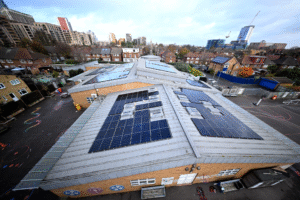The Thames Estuary invests in new hydrogen infrastructure to help the UK achieve net-zero by 2050.
The Thames Estuary presents a unique opportunity for investment in Hydrogen Infrastructure at scale like nowhere else in the UK.
The UK has a net-zero carbon pledge by 2050, which has brought into focus the significance of hydrogen power in helping us to achieve a decarbonised future, not least by The Prime Minister’s announcement for a 10-point climate plan, which included ensuring five gigawatts of low-carbon hydrogen energy production capacity by 2030.
With mounting pressure to make the transition, the Thames Estuary has launched its plan to establish a world-class hydrogen ecosystem.
What are the opportunities?
Situated next to one of the world’s leading cities that has strong targets around zero emissions, with a large demand on its energy and transport infrastructure, the Estuary can present a critical mass in its shift towards a decarbonised future at scale, which will become highly attractive to investors.
We also have critical mass that will enable adoption at scale, as well as large opportunities in air and port side uses, public transport with the TFL bus fleet, and other municipal uses as well as a significant logistics sector to service.
We have already made progress with an exploration of a transition to incorporating hydrogen in the domestic gas supply and new plants to manufacture hydrogen for public transport are coming forward.
Additionally, with large brownfield sites and an existing petrochemical infrastructure, the time is right to put in place a plan to transition towards a low, and ultimately zero-carbon future.
We have the ingredients (the sites, access to water, the desire) and the opportunity (a clear shift in demand) to create a compelling case for investment in hydrogen in the Thames Estuary.
As well as the environmental benefits, there is an opportunity to unlock £18bn GVA and create 75,000 new jobs in the Thames Estuary region alone. This is key for the levelling up agenda and promoting economic growth post-Brexit and post-Covid.
Why Hydrogen?
A major benefit of hydrogen power is that it generates electrical power emitting only water vapour and warm air.
Mass adoption of hydrogen power will have a huge impact in improving the air quality in and around the Estuary.
It is known that there are a few hotspots in the region with particularly poor air quality. By encouraging heavy goods vehicles to switch to make the transition to hydrogen this will clean up the surrounding air, significantly reduce the risk to people’s respiratory health, and as a knock-on effect alleviate the pressures on the NHS. The benefits of hydrogen are multitudinous and far-reaching.
Hydrogen power enables you to make more use of renewable energy sources. For example, the Estuary itself has a number of wind farms as a renewable alternative to fossil fuels.
However, when the demand is present for energy, that is not necessarily the precise moment when the wind is blowing, and therefore a back-up supply is required. Hydrogen offers a solution for any access demand on the basis that it can be stored for later use. This is not to say hydrogen is a silver bullet for decarbonisation, but undeniably it has a significant role to play going forward.
Research by our colleagues at The University of Kent has predicted that there is an estimated 2050 regional demand of 0.8 million- 1.25 million tonnes of Hydrogen per annum across the Estuary Region.
These predictions are a product of estimated demand across those key sectors: transport, domestic and commercial gas, manufacturing industries and power generation.
This would require an eight-fold increase in renewable energy capacity for the Thames Estuary between now and 2050. This is the tremendous scale of opportunity we have for measured growth across the renewable energy sector in our Growth Board Region.
Next steps
With this significant demand case for positive environmental innovation and change, the Thames Estuary Growth Board held its first summit, comprised of leading experts and stakeholders, to devise a plan for unlocking the potential of hydrogen power in the Estuary.
This was attended by representatives from the National Grid, renewable energy company Ryse, and Port of London Authority’s, to name a few.
Following the event, the Growth Board is drawing up a roadmap to developing a hydrogen ecosystem, but there are some clear next steps that have already been identified:
Establish demand – At present hydrogen power is expensive, but economies of scale will bring this down over time. We need to establish the size of the market that would be created and the key points in time for investment. Moreover, we need to embrace Government policy, incentives, and pricing mechanisms to accelerate widespread adoption.
Identify potential investment sources and create a market proposition – In the first stages, develop our opportunity road map to secure investment to prove the concept and build confidence.
Establish Credibility and Confidence – A key part of adopting new technologies will be enabling businesses to see how the new technologies can work for them in real-life applications.
Enable Research – Establish where the main areas of research are and develop the Estuary as a test bed for implementation.
Develop Supply – In the very short term, we may need to rely on importing hydrogen from elsewhere because the demand in early stages may not be sufficient for investment.
Identify Manufacturing Infrastructure – Hydrogen manufacture requires a significant amount of energy. Electrolysis is the least polluting method, but only if the electricity used comes from renewable sources – we will therefore need to significantly increase our generation of electricity from renewable sources.
Transition Technologies – We will need to consider the end-users and how they may transition to a fully carbon free approach.
The benefits of a hydrogen-fuelled future are vast, and the Thames Estuary is in a good place to help power the nation sustainably, helping us all on the road to good, green growth.
















Great picture painted by Kate Willard. How to engage & participate is the question.